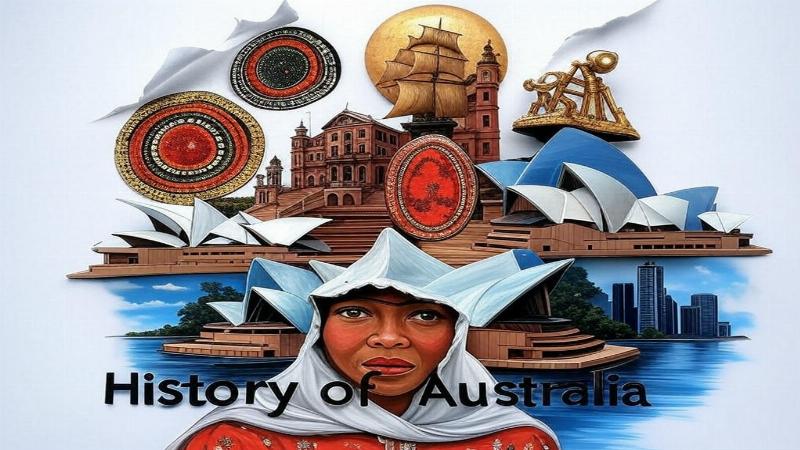Place for ads

Australia, a vast island continent spanning 7.7 million square kilometers, is a land of ancient heritage and modern ambition. From its rugged Outback to its bustling cities like Sydney and Melbourne, it’s a nation shaped by its Indigenous peoples, European settlers, and waves of global influence. Known today for its natural wonders and multicultural society, Australia’s history stretches back over 65,000 years, weaving a story of resilience, transformation, and discovery. In this article, we’ll trace Australia’s past, from its earliest inhabitants to its present-day identity, exploring the milestones that define this unique land.
Australia’s human history begins with its Indigenous peoples, who arrived around 65,000 years ago—possibly earlier—via land bridges from Southeast Asia. Archaeological sites like Lake Mungo, where 40,000-year-old remains were found, reveal a sophisticated culture of hunters, gatherers, and fishers. These first Australians, now collectively called Aboriginal and Torres Strait Islander peoples, developed over 250 languages and a deep spiritual connection to the land, known as the Dreamtime.
By 10,000 BCE, rising seas isolated Australia, fostering unique traditions. Rock art at Uluru and the Kimberley, some dating back 20,000 years, depicts animals and ceremonies, while tools and trade networks—like ochre from South Australia
Place for ads
Dutch navigator Willem Janszoon became the first European to chart Australia’s coast in 1606, landing on Cape York. Over the next century, Dutch explorers like Abel Tasman—who named Tasmania “Van Diemen’s Land” in 1642—mapped parts of the continent, calling it “New Holland.” They found it arid and uninviting, leaving no settlements.
In 1770, British Captain James Cook sailed the east coast, claiming it as “New South Wales” for Britain. His reports of fertile land and strategic harbors sparked interest, setting the stage for colonization. Indigenous peoples, unaware of the shift, faced a looming upheaval as European ships returned with purpose.
In 1788, the First Fleet—11 ships carrying convicts, soldiers, and supplies—arrived at Botany Bay, then settled at Port Jackson (now Sydney). Led by Captain Arthur Phillip, this marked the start of British Australia. Over 162,000 convicts were transported between 1788 and 1868, sentenced for crimes like theft, to ease Britain’s overcrowded prisons.
Colonization devastated Indigenous populations. Disease—smallpox, measles—killed thousands, while land seizures sparked resistance. The 1790s saw clashes like the Hawkesbury and Nepean Wars, where Aboriginal warriors fought settlers. By 1820, the colony expanded to Tasmania and beyond, driven by wool and farming.
The 1851 discovery of gold near Bathurst, New South Wales, ignited a frenzy. Within a decade, Victoria’s Ballarat and Bendigo fields drew 500,000 prospectors—British, Chinese, Americans—tripling Australia’s population to over 1 million by 1861. Gold funded infrastructure—roads, railways—and swelled cities like Melbourne into bustling hubs.
The rush birthed the Eureka Rebellion in 1854, when miners at Ballarat protested taxes and conditions, raising the Southern Cross flag. Though crushed, it spurred democratic reforms, like voting rights for men in Victoria. Meanwhile, Indigenous displacement worsened as settlers claimed resource-rich lands.
By the late 19th century, Australia’s six colonies—New South Wales, Victoria, Queensland, South Australia, Tasmania, and Western Australia—sought unity. Economic ties, defense needs, and a shared British identity drove the push. After conventions in the 1890s, the Commonwealth of Australia was born on January 1, 1901, with Edmund Barton as its first prime minister.
The new nation adopted the White Australia Policy, restricting non-European immigration—a stain on its early years. Canberra, a planned capital, emerged in 1913, symbolizing unity. Federation marked Australia’s shift from colonial outpost to sovereign state, though it remained tied to Britain.
Australia’s baptism by fire came in World War I. Over 416,000 enlisted, with 60,000 dying—many at Gallipoli in 1915, a campaign etched into national memory as ANZAC Day. The war cemented Australia’s loyalty to Britain but also its distinct spirit. Returning soldiers fueled growth, though the 1930s Depression hit hard, with unemployment soaring.
World War II struck closer. Japan’s 1942 bombing of Darwin and submarine attacks on Sydney Harbor brought war to Australian soil. Over 1 million served, with key victories in New Guinea. Post-war, immigration boomed—Italians, Greeks, and others joined under “populate or perish,” diversifying a once-Anglo nation.
The 1950s and ’60s ushered in prosperity. The Snowy Mountains Scheme, a massive hydro project, employed migrants and powered growth. Suburbs sprawled, and icons like the Sydney Opera House (begun 1959) symbolized ambition. The economy leaned on wool, wheat, and mining—iron ore and coal later boomed.
Indigenous rights gained traction. The 1967 referendum, with 90% approval, counted Aboriginal people in the census and let the federal government legislate for them—steps toward equality after decades of neglect under policies like child removal (the Stolen Generations).
The 1970s saw seismic shifts. Gough Whitlam’s Labor government (1972–1975) ended White Australia, boosted arts, and recognized China. His 1975 dismissal by Governor-General John Kerr sparked a constitutional crisis, but democracy held. The 1980s and ’90s, under Bob Hawke and Paul Keating, embraced free markets, floating the dollar and cutting tariffs.
The 2000 Sydney Olympics showcased Australia globally, while the 1996 Port Arthur massacre led to strict gun laws under John Howard (1996–2007). Indigenous reconciliation advanced with the 2008 apology by Kevin Rudd to the Stolen Generations, though land rights remain contested.
Today, Australia’s 26 million people reflect diversity—over 30% are foreign-born, from Asia, Europe, and beyond. Sydney and Melbourne rival global cities, while the Outback retains its mystique. Mining and tech drive the economy, but climate change—bushfires, droughts—looms large, as seen in the 2019–2020 Black Summer.
Challenges include Indigenous inequality, immigration debates, and ties with China. Yet, Australia’s culture—sport, barbecues, and a laid-back ethos—thrives, rooted in a history that spans ancient Dreamtime to modern innovation.
Australia’s history is a saga of endurance and evolution. From Indigenous custodians who shaped the land for millennia to settlers who forged a nation, it’s a story of adaptation against a wild backdrop. As Australia navigates the 21st century, its past—from Uluru’s red heart to Sydney’s harbor—fuels a legacy that resonates worldwide.
Place for ads